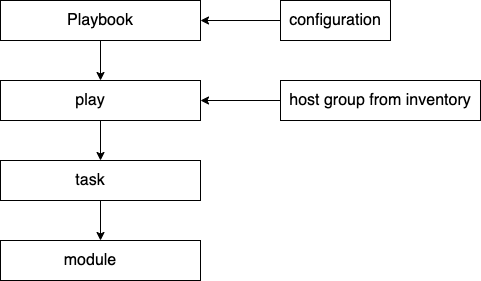Configuration Management
Contents
Configuration Management¶
Outline of the topic:¶
Major HPC installation types and configuration management challenges
Detail what configuration management is and why it is useful
Review the current landscape of available tools
Ansible basics and examples:
configuration files
playbooks
commands for remote tasks
Major HPC installation types and management challenges¶
Traditional diskful (“stateful”) compute nodes¶

The operating system and applications reside on the local system drive.
They are preserved at system reboot.
Configuration management challenge:
keeping the OS and apps identical across the cluster nodes.
Configuration tools: ansible, puppet, chef, salt, cfengine.
This is the type of installation we have here, at the LCI workshop.
Network booted diskless (“stateless”) compute nodes¶

Operating system boots up from network.
The root file system
/resides either in ramdisk or nfs-root (ro-mounted).Applications can be either in ramdisk, or on nfs (
ro-mounted), or on local disk (satelite installation).Configuration management challenges:
ramdisk (initrd) configuration
possible excessive network traffic
nfs-root redundancy and caching
maintain identical software content on a local disk for satelite systems.
Configuration tools: initramfs-tools, dracut, xCAT, Warewulf3 (outdated).
Defining Configuration Management¶
At its broadest level, the management and maintenance of operating system and service configuration via code instead of manual intervention.
More formally:
Declaring the system state in a repeatable and auditable fashion and using tools to impose state and prevent systems from deviating
State¶
All system have a ‘state’ comprised of:
Files on Disk
Running services
State can be supplied by:
Installation / provisioning systems
Golden Images
Manual steps including direct configuration changes and setup scripts
Modern Configuration Management Features¶
Idempotency
Declaration and management of files and services to reach a ‘desired state’
Revision Control
Systems are managed with an ‘Infrastructure as code’ model
Composable and flexible
Benefits of configuration management¶
Centralized catalog of all system configuration
Automated enforcement of system state from an authoritative source
Ensured consistency between systems
Rapid system provisioning from easily-composed components
Preflight tests to ensure deployments generate expected results
Collection of system ‘ground truths’ for better decision making
Modern configuration-management systems¶
Puppet
Ruby based
Chef Infra
Ruby based
CFEngine
C based
Salt
Python based
Ansible
Python based
How Ansible works¶
Ansible connects to compute nodes via
sshas a regular user.Needs either public-private key for the user running ansible, or host based authentication configured.
Forks several instances to ssh concurrently to multiple nodes.
Elevates root privileges via
sudo.Needs sudo privilege on the nodes for a user running ansible.
Runs configuration/management tasks via
pythonmodules.Needs python3 as well as Ansible python modules (ansible-core) installed.
The tasks are defined in Ansible
playbooks(yaml files).The admin needs to understand yaml syntax for ansible tasks.
Doesn’t touch the system and configuration if they are already in the desired final target state.
A simple Ansible setup example¶
Ansible file structure for MPI installation on the compute nodes. All the files are under:
Lab_MPI
\Ansible
├── ansible.cfg
├── Files
│ └── openmpi-4.1.5-1.el8.x86_64.rpm
├── hosts.ini
├── install_mpi.yml
└── setup_mpiuser.yml
The main config file, ansible.cfg on our cluster¶
[defaults]
inventory = hosts.ini
remote_user = instructor
host_key_checking = false
remote_tmp = /tmp/.ansible/tmp
interpreter_python = /bin/python3
forks = 4
[privilege_escalation]
become = true
become_method = sudo
become_user = root
become_ack_pass = false
Inventory (hosts) file hosts.ini¶
[all_nodes]
compute1
compute2
compute3
compute4
[head]
localhost ansible_connection=local
Package installation example, install_mpi.yml¶
The file can have any name.
The extension is
.yaml.The configuration syntax is Yaml.
Ansible spools the rpm file,
openmpi-4.1.5-1.el8.x86_64.rpm, into local/tmpdirectory on the nodes, then installs it.All the work is done by the
tasks:
---
- name: Install a package on the head and compute nodes
hosts: head, all_nodes
gather_facts: no
tasks:
- name: copy mpi rpm file
ansible.builtin.copy:
src: Files/openmpi-4.1.5-1.el8.x86_64.rpm
dest: /tmp
owner: root
group: root
mode: '0644'
- name: install openmpi
ansible.builtin.dnf:
name: /tmp/openmpi-4.1.5-1.el8.x86_64.rpm
disable_gpg_check: yes
state: present
Ansible organization: playbook, play, role, and task.¶
Plays are associated with groups of hosts in the inventory.
Roles contain collections of reusable tasks.
Tasks perform all the work by utilizing modules.

Ansible modules¶
The modules are used by tasks to do work.
The most commonly used modules:
copy files:
ansible.builtin.copyset file attributes:
ansible.builtin.fileinstall packages:
ansible.builtin.dnfandansible.builtin.aptexecute shell commands:
ansible.builtin.shellrestart a service:
ansible.builtin.service
To see all installed on your system modules:
ansible-doc -l
Read the info on a specific module, for example,
ansible.builtin.file:ansible-doc ansible.builtin.file
Examples of utilizing ansible.builtin.shell module for a remote command¶
Use module
ansible.builtin.shellfor a remote command.For example, check the status of
slurmdon all the nodes:
ansible all -m ansible.builtin.shell -a "systemctl status slurmd"
Restart
slurmdon compute1:
ansible compute1 -m ansible.builtin.shell -a "systemctl restart slurmd"
Ansible playbook development steps¶
Set Configuration files:
ansible.cfgandhosts.ini.Identify groups of hosts to execute identical tasks on (plays)
Define the top-level playbook tasks (roles).
Add features you need in new yaml files.
Place configuration files and packages in the
filesdirectories for the roles.Tag the tasks for debugging purposes.
Check the playbooks for syntactic errors:
ansible-playbook playbook.yml --syntax-check
Perform a dry run:
ansible-playbook playbook.yml --check
List the tagged tasks:
ansible-playbook --list-tags playbook.yml
Run only the tagged task in the playbook with tag
compilation, for example:
ansible-playbook --with-tags compilation playbook.yml
Run the playbook:
ansible-playbook playbook.yml

